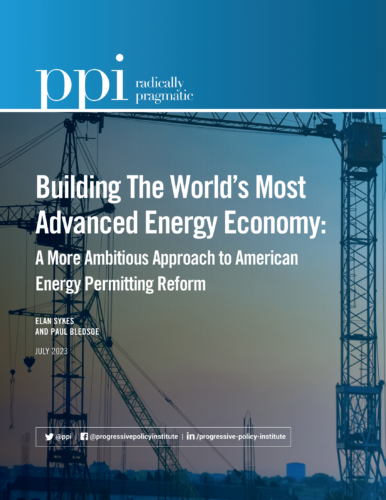America needs to build bigger and cleaner. Facing economic and regulatory headwinds that affect our ability to grow the economy, channel investment into clean energy, and scale up the technologies needed to prevent climate change, we can no longer accept the burden of a regulatory framework designed for different problems and offering then-current solutions half a century ago that now penalizes and delays cleaner projects in the name of environmental protection. Reforming this system of environmental reviews under the National Environmental Policy Act (NEPA) and the many types of permits issued by federal agencies that require a prerequisite NEPA review is a necessary shift in economic and climate policy that remains unfinished.
In 2021 and 2022, Congress passed a trio of much-needed laws designed to grow and update U.S. infrastructure, clean energy technology, and research and development. Allocating over a trillion dollars in funding across a wide range of policy tools, the bills included tax credits, grants, and loans; a wide range of technologies, including not just technology-specific boosts like the hydrogen tax credits or grants for port modernization but also technology-neutral incentives for clean energy generation; and a wide distribution of benefits, both in geographic and socioeconomic terms.
Yet this funding cannot manifest as meaningful real-world construction under the current policy structure: According to data from the Federal Permitting Improvement Steering Council, the average time from formal start to final decision for projects under NEPA review averaged 4.3 years for transmission lines, 3.5 for natural gas pipelines, and 2.7 years for renewable energy generation projects. In order to maximize the public return on investment and build public confidence in this program, projects will need to move out of the theoretical realm and into the ground to start providing people with tangible results in the form of cheaper, cleaner power, bigger and better factories producing clean new cars and appliances, and also new facilities to produce the materials and components needed for all of this new technology.
Policymakers on both sides of the aisle have an interest in fixing this issue. A deal between Senator Joe Manchin and Majority Leader Senator Chuck Schumer in the fall of 2022 secured support from nearly all Senate Democrats for permitting reform modeled on existing programs for transportation and other infrastructure. PPI endorsed that effort and issued a major report with further policy recommendations at the time, but the measure fell short for lack of Republican support. This spring, in addition to several new Democratic proposals from President Biden, Senator Tom Carper, and Representatives Sean Casten and Mike Levin, Republicans introduced several iterations of their own reforms. As part of an agreement to raise the debt ceiling reached between President Biden and the Republican-majority House in May, Congress passed a series of fiscal measures and included parts of Rep. Garret Graves’ BUILDER Act as a first-pass set of permitting reforms. Specifically, these include:
• Streamlined interagency review process with a lead agency and coordinated timetables;
• 1-2 year “Shot clocks” to encourage faster environmental reviews;
• Sharing Categorical Exclusions across federal agencies;
• Minor changes to NEPA (National Environmental Policy Act) changes: Programmatic NEPA reviews are authorized for use in subsequent documents for five years without further study, Page limits are imposed for NEPA documents (not including citations or appendices), clear standards for levels of review for different actions, narrow changes for the consideration of project alternatives and impacts, including considering the environmental benefits of a project, and authorizing a study on E-NEPA (improvements to the law’s administrative technology suite);
• Other changes: giving energy storage projects eligibility for the FAST-414 permit streamlining process, approving the Mountain Valley Pipeline, and authorizing a study on interregional transfer capacity for U.S. electric grids.
These reforms, which line up with PPI’s September 2022 recommendations, were negotiated under the severe pressure of default, and will unlock small but meaningful gains in permitting timelines and costs. They did not, however, include appropriately the ambitious changes required to fully modernize the sorely outdated American regulatory process and unleash clean energy deployment that can outcompete the rest of the world.
The imperative to deploy clean energy as quickly and cheaply as possible has not changed, but with Congress split and only part of the task complete, the political calculus has. Policymakers on both sides of the aisle have proposed crucial pieces of an even more ambitious reform package, and both need the other’s support to accomplish their own self-defined goals. While many progressive Democrats opposed reform last September, even their stance may be shifting as stalwart environmentalists like Bill McKibben, previously a dedicated activist focused on stringent supply-side fossil fuel restrictions, have come out in favor of shaking up the permitting system at least for the cleanest and most urgent projects for climate progress. The Republican-led House and Democratic-majority Senate will need to avoid polarizing themselves out of a deal that would bring substantial, meaningful wins to both their base constituencies on their own terms. Both sides must realize that a permitting and transmission deal will provide huge benefits to all major constituencies and stakeholders such that policy compromises will be rewarded politically rather than punished.
Agreement is not yet assured, but it is possible if a deal contains both broader reforms of permitting under NEPA than the debt ceiling deal, along with better coordination of compliance with other relevant environmental laws and appropriately scaled changes to the process of planning, siting, and paying for crucial electricity transmission. Both elements — NEPA reforms and transmission expansions — will be necessary for legislation to bring about a true renaissance in the U.S. energy economy that will provide unprecedented economic benefits to consumers, workers, and businesses while boosting U.S. competitiveness and reducing emissions.
